Summarized by Walter Sorochan
Posted 2012; Updated November 13, 2021.
Nikola Tesla (1856-1943)
Tesla: the father of the electronic era
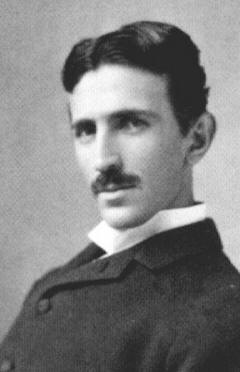 Tesla was unceremoniously thrown out of the best technical school in Yugoslavia for believing that he could build a generator that would extract electrical power from a running stream of water. His professor called it: "Perpetual Motion!"
Tesla was unceremoniously thrown out of the best technical school in Yugoslavia for believing that he could build a generator that would extract electrical power from a running stream of water. His professor called it: "Perpetual Motion!"
Having an idea rejected by the establishment is not so unfamiliar. We have heard other such convenient explanations, such as: "Heavier than air machines will never fly" (Lord Kelvin, 1890s); "We threw out all of the textbooks, and then we built the airplane" (the Wright Brothers); "The human body will not survive speeds of over 40 miles per hour" (early 1900s); and "Airplanes can not go faster than the speed of sound" (1940s). Other examples abound, all spoken by the out-spoken "leaders" of their day.
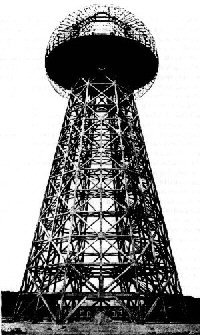 And so it is with the new idea like electricity as an energy that could replace candles and oil lamps in homes and offices.
Tesla harnessed electricity and was the architect that built the first commercial hydro plant in Niagara Falls to
make electricity. His invention provided light for the world.
And so it is with the new idea like electricity as an energy that could replace candles and oil lamps in homes and offices.
Tesla harnessed electricity and was the architect that built the first commercial hydro plant in Niagara Falls to
make electricity. His invention provided light for the world.
Tesla's genius did not stop with providing electricity for home and industries. He experimented with a machine and a tower [ on left side ] that extracted free energy from the air. That is, free energy from space or air. Tesla came up with this idea before 1900 and he was ridiculed!
Tesla was perhaps the greatest inventor of our time. He was also the inventor that was also forgotten! Nikola Tesla was an immigrant from what is now Croatia, Yugoslavia; there's a museum of his works in Belgrade. He's virtually unknown in the United States, despite his accomplishments. Some people feel it's a government plot, the same people who are into conspiracy theories.
Although Tesla was a brilliant inventor, he was a very bad businessman; he ended up dying penniless and broke. Businessmen who go broke often fade out of the public eye; we see this in the computer industry all the time. Edison, who wasn't near the inventor Tesla was, but who was a better businessman, is much better remembered, as is his General Electric. Still, look at the incomplete list of Tesla's inventions:
Tesla, in short, invented much of the equipment that gets power to your home every day from miles away, and many that use that power inside your home. His inventions made George Westinghouse (Westinghouse Corp.) a wealthy man. Finally, the unit of magnetic flux in the metric system is the "tesla." Other units include the "faraday" and the "henry", so you'll understand his is an honor given to few. So we're not talking about an unknown here, but rather a solid electrical engineer.
1. the AC motor and transformer. (Think of every motor in your house.)
2. 3-phase electricity
3. popularized alternating current
4. the electrical distribution system used all over the world
5. the Tesla Coil, which makes the high voltage that drives the picture tube in your computer's CRT,
7. the spark that ignites the fuel in your automobile
8. credited with inventing modern radio as well; the Supreme Court overturned Marconi's patent in 1943 in favor of Tesla
9. voice recorder
10. television
11. dark idea to black out a city [ cancel or freeze all electricity ] as way to stop war
12. ignition system used in all autos
13. speedometer
14. ship's log
15. electric car 1897 speed of 94mph & over 300 miles before battery recharge
16. battery for electric auto
17. cosmic ray
18. robot
19. speech translator
20. earthquake machine
21. wireless system for ships
22. death ray
23. radar
24. 700 patents for inventions
Tesla whipped through a number of inventions early in his life. He found himself increasingly interested in resonance [ vibration of things ], and in particular, electrical resonance. Tesla found out something fascinating. If you set an electrical circuit to resonating, it does strange things indeed. Take for instance his Tesla Coil. This high frequency step-up transformer would kick out a few hundred thousand volts at radio frequencies. The voltage would come off the top of his coil as a "corona", or brush discharge. The little ones put out a six-inch spark; the big ones throw sparks many feet long. Yet Tesla could draw the sparks to his fingers without being hurt -- the high frequency of the electricity keeps it on the surface of the skin, and prevents the current from doing any harm. Tesla got to thinking about resonance on a large scale. He'd already pioneered the electrical distribution system we use today, and that's not small thinking; when you think of Tesla, think big.
He thought, let's say I send an electrical charge into the ground. What happens to it? Well, the ground is an excellent conductor of electricity.
In the early 20th century Nikola Tesla was the first to discover the scalar wave. He used induction coils to create these scalar waves. He had conducted many experiments while sending scalar waves around the Earth proving that scalar waves propagate over long distances with no loss in field strength. Unlike our current familiar electromagnetic wave that dissipates and looses its energy at a rate equal to the square of the distance from the source, Tesla’s longitudinal waves could travel any distance with practically no loss of energy.
Tesla in his time believed in the existence of the aether [ he called it radiant energy ] and that it
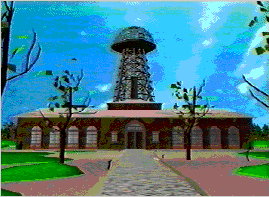 could be harnessed for free energy that could be the salvation of humankind. He addressed the American Institute of Electrical Engineers in 1891 with these words; ‘.. with the power derived from it, with every form of energy obtained without effort, from stores forever inexhaustible, humanity will advance with great strides, it is a mere question of time when man will succeed in attaching their machinery to the wheelwork of nature."
could be harnessed for free energy that could be the salvation of humankind. He addressed the American Institute of Electrical Engineers in 1891 with these words; ‘.. with the power derived from it, with every form of energy obtained without effort, from stores forever inexhaustible, humanity will advance with great strides, it is a mere question of time when man will succeed in attaching their machinery to the wheelwork of nature."
Tesla built a working system that included a tower to capture the free energy from the air and a machine to convert free energy into usable electricity. For this he was ridiculed and ignored by rich magnates as availability of free energy would not make any money for them. The tower was destroyed several years later by the USA government!
Part 2 Productive years
Part 1 - The Early Years
From the time he was a child, Tesla was always considered eccentric.
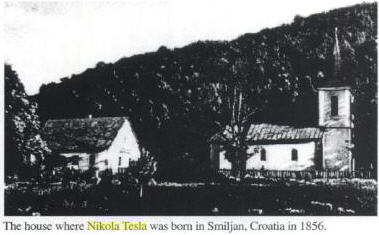 During his early life, Tesla was stricken with illness time and time again. He suffered a peculiar affliction in which blinding flashes of light would appear before his eyes, often accompanied by hallucinations. The flashes and images caused Tesla great discomfort, and by the time he reached his teens he had taught himself to repress them from occurring except in certain times of stress.
During his early life, Tesla was stricken with illness time and time again. He suffered a peculiar affliction in which blinding flashes of light would appear before his eyes, often accompanied by hallucinations. The flashes and images caused Tesla great discomfort, and by the time he reached his teens he had taught himself to repress them from occurring except in certain times of stress.
Shortly after his graduation from high school, Tesla suffered a devastating bout with cholera and nearly died. He was bedridden for nine months, and doctors announced that he would not live much longer. Tesla underwent another debilitating trauma a few years after recovering from cholera. This time, the nature of the illness and its causes were a complete mystery. Tesla's physical senses, which had always been remarkably acute, seemed to go inexplicably into overdrive, paralyzing him with an overabundance of sensation.
Tesla shunned physical contact with other people, with a special aversion to touching hair. To avoid shaking hands with people he met, he lied that he had injured his hands in a laboratory accident. He apparently never took part in a romantic relationship of any kind. A female acquaintance who grew enamored of Tesla reportedly once took the initiative to kiss him, causing the startled inventor to flee in agony.
Tesla asserted that it was not until he reached adulthood that he discovered he was an inventor. He discounted his early years as a time of undisciplined impulses, entirely lacking focus. But he did invent a wide array of creations and schemes as a child. The young Tesla created a remarkable machine powered by another natural energy source: June bugs (or, as Europeans call them, May bugs). He glued sixteen of the live insects to the blades of a small windmill-like structure, and they set the rotor spinning vigorously in their vain attempt to fly away.
Tesla began his college education at Graz Polytechnic Institute, pursuing studies of the topic that fascinated him above all others: electricity. Tesla was an extraordinary student who frequently enraged his professors, questioning the technological status quo with an insight that surpassed his instructors. He rebelled most stringently against the acceptance of direct current as the sole means of delivering electrical power.
It was plain to him that DC was inefficient and incapable of adequately
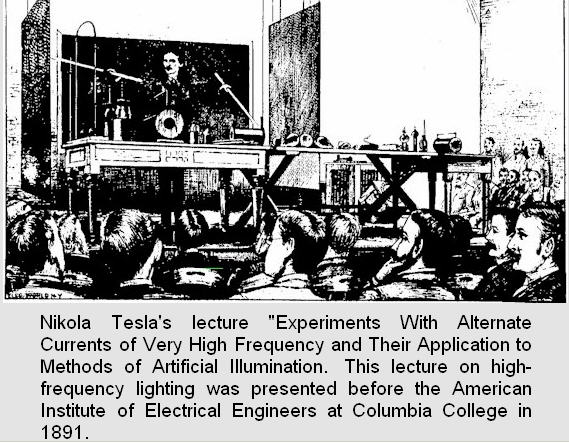 transmitting power over long distances, and there had to be a better way. There was talk of a theoretical "alternating current" system, but no one had figured out how to make it work. AC was frowned upon as a fanciful dream by the scientific establishment, in much the same way as cold fusion is regarded today. Tesla's merest suggestion of AC brought scorn in his lecture halls, but he was never discouraged enough to abandon the enticing riddle.
transmitting power over long distances, and there had to be a better way. There was talk of a theoretical "alternating current" system, but no one had figured out how to make it work. AC was frowned upon as a fanciful dream by the scientific establishment, in much the same way as cold fusion is regarded today. Tesla's merest suggestion of AC brought scorn in his lecture halls, but he was never discouraged enough to abandon the enticing riddle.
In the middle of Tesla's sophomore year of college, his father was felled by a stroke. Nikola returned home, and his father died soon after. Tesla never returned to the Polytechnic Institute. Lacking funds for tuition, he took a job at a government telegraph office. Tesla despaired for his interrupted education, but held on to his dream of becoming an electrical pioneer. It was at this time that Tesla endured his ordeal with hypersensitivity that reduced him to a bedridden invalid. Considering the depressing turns his life had just taken, the bizarre affliction could possibly have been psychosomatic in origin. Whatever its cause, when Tesla finally emerged from the prolonged fugue state, he was armed with a powerful new insight on how alternating current could be successfully attained.
His great mental leap was this: two coils positioned at right angles and supplied with alternating current 90 out of phase could make a magnetic field rotate, with no need for the cumbersome commutator used in direct current motors . Tesla knew it would work without even having to build it and test it. Constructing it mentally and letting it run in his mind was proof enough for him. This was Tesla's method for developing inventions throughout his career: no journals, no blueprints, no prototypes.
Tesla now possessed the answer, but the problem of putting it into practice remained.
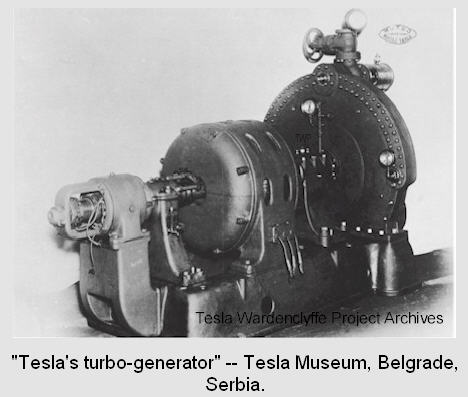 In 1882 he found employment with Continental Edison Company in Paris, distinguishing himself as a fine engineer, and, while on assignment to Strassburg in 1883, he constructed, in after-work hours, his first induction motor. In 1884 Tesla was invited to come to America and work for the Edison Company and redesign Edison's machines. Edison made him work from 10:30 am to 5:00 the next morning, seven days a week. Even though Tesla did not believe in Edison's direct current motors he worked hard to improve them.
In 1882 he found employment with Continental Edison Company in Paris, distinguishing himself as a fine engineer, and, while on assignment to Strassburg in 1883, he constructed, in after-work hours, his first induction motor. In 1884 Tesla was invited to come to America and work for the Edison Company and redesign Edison's machines. Edison made him work from 10:30 am to 5:00 the next morning, seven days a week. Even though Tesla did not believe in Edison's direct current motors he worked hard to improve them.
Edison told him if he could do that he would give him a bonus of $50,000. Tesla worked day and night because the $50,000 would let him set up his own lab and work on his inventions. He came up with twenty-four new designs to replace the old ones of Edison's. Edison was delighted with the results but did not pay Tesla the $50,000 he had promised. When Tesla finally asked him about it, it is said that Edison told him, "Tesla, you don't understand our American humor." That is when Tesla left the Edison Co. and they became rivals. A group of inventors approached him and offered him a chance to form a company of his own: "the Tesla Electric Light Company"
Tesla developed a light that was simpler, more reliable, safe, and economical than what was being used. He patented the lights and they were installed throughout the town. This was a great success, however, all of a sudden the investors took over the company from Tesla. Now, once again, he had no job, no money, and he didn't even own the patents on the things he had developed. He couldn't get an engineering job, so, for a year Tesla worked as a laborer on street gangs, digging ditches and building streets. However, he worked on his inventions during this time and received several more patents. A lot of his inventions didn't really have any use at the time, but became useful years later. For example, he developed a way to transform heat directly into mechanical or electrical energy. This process was "rediscovered" in the 1970's and Tesla was never given credit for it. He said that it was the most depressing time of his life. He even planned on committing suicide on his upcoming thirtieth birthday, at the stroke of midnight.
Before that could happen, A. K. Brown of Western Union Telegraph Company learned of Tesla's plight. Aghast, Brown was determined to restore the genius to a worthy place, and offered to furnish him with a laboratory of his own. And what's more, Brown wanted Tesla to pursue the possibilities of alternating current. Granted a blessed salvation, Tesla immediately went to work assembling his AC dynamo at last. It functioned in reality precisely as it had all those years inside his head. Tesla demonstrated his invention in a heavily publicized lecture, and instantly became the toast of the engineering community. In 1887 George Westinghouse, who owned most of the electric companies and was a competitor of Edison, went to see Tesla and his alternating current motor. Westinghouse was kind of like Edison in that he was ruthless, but Tesla liked him. Tesla sold his patents to Westinghouse for $60,000 (only $5,000 in cash and 150 shares of stock), and went to work for Westinghouse. He was also supposed to get $2.50 for every horsepower of electricity sold. If that had happened he would have been a billionaire! The transaction precipitated a titanic power struggle between Edison's direct-current systems and the Tesla-Westinghouse alternating-current approach, which eventually won out.
Tesla soon established his own laboratory, where his inventive mind could be given free rein.
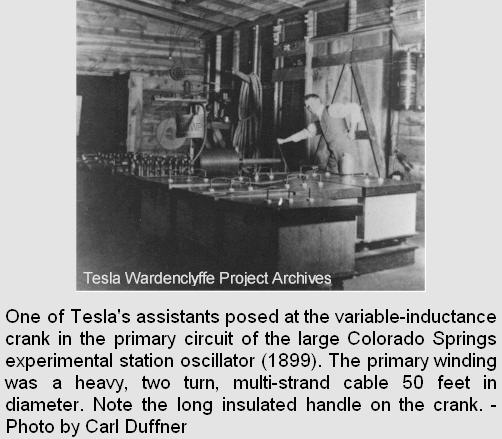 He experimented with shadowgraphs similar to those that later were to be used by Wilhelm Röntgen when he discovered X-rays in 1895 . Tesla's countless experiments included work on a carbon button lamp , on the power of electrical resonance, and on various types of lighting. Tesla gave exhibitions in his laboratory in which he lighted lamps without wires by allowing electricity to flow through his body, to allay fears of alternating current. The Tesla coil , which he invented in 1891, is widely used today in radio and television sets and other electronic equipment. The typical frequency range is from 100 kHz to 1M Hz with typical voltages of several 100kV.) That year also marked the date of Tesla's United States citizenship.
He experimented with shadowgraphs similar to those that later were to be used by Wilhelm Röntgen when he discovered X-rays in 1895 . Tesla's countless experiments included work on a carbon button lamp , on the power of electrical resonance, and on various types of lighting. Tesla gave exhibitions in his laboratory in which he lighted lamps without wires by allowing electricity to flow through his body, to allay fears of alternating current. The Tesla coil , which he invented in 1891, is widely used today in radio and television sets and other electronic equipment. The typical frequency range is from 100 kHz to 1M Hz with typical voltages of several 100kV.) That year also marked the date of Tesla's United States citizenship.
Tesla became known for the lectures at which he demonstrated his inventions and concepts with a theatrical flair. Many attendees were laymen who had little comprehension of what Tesla said, but were mesmerized by the bolts of lightning that leapt from his ominously humming coils, and the unwired light bulbs that lit at the touch of Tesla's hand.
--------------------------------------------------------------------------------
Additional information on Tesla: Tesla Biography;Get your own authentic photograph; patents, photos